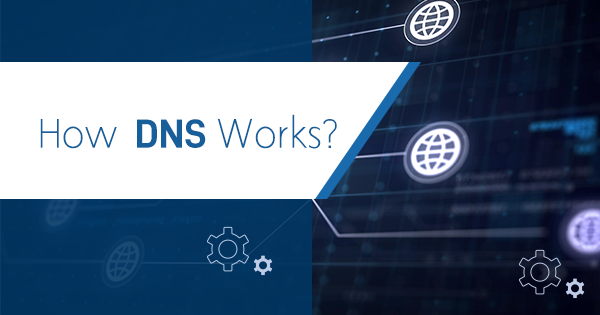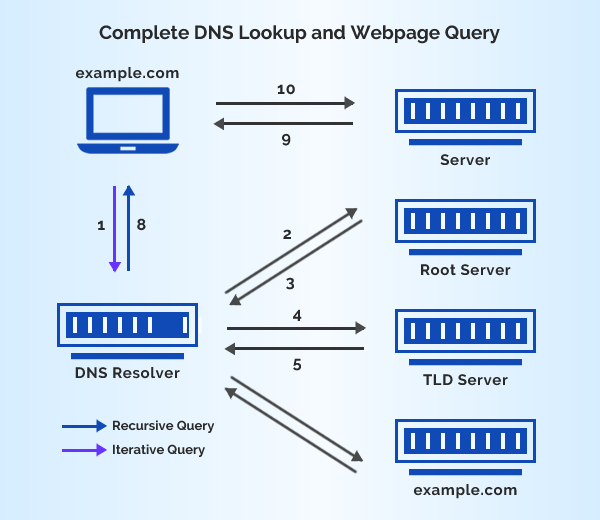What is DNS? It can be simply understood as the data book of the web. Some also claim it as the digital phone book. Users, in general, collect information over the web through the domain name. In the case of the browsers, the communication occurs through IP or Internet Protocol address.
So the questions like what is DNS can be simply understood as DNS converts domain names in terms of IP addresses to enable the browsers to provide web resources. What is DNS and how it works is one of the frequently asked questions in modern times? The following abstracts discuss each aspect about it with utmost clarity and the simplest possible way.
Preparing for an AWS certification? Check out our AWS Certification Training Courses!
Anyway, one must first understand that every device linked with the web has an explicit IP address that other devices make use of for distinguishing it. So, the simplest answer for what is DNS and how it works would be that DNS servers abolish the burden on human memory to keep the IP address in mind. The following abstract discusses how DNS works step by step for greater understanding.
Basics of How DNS Works?
The method of DNS resolution is simply about turning the hostnames into a system-friendly IP address. In general, an IP address is provided to every device, as explained above. As a user goes for uploading a webpage, it becomes important for the user inputs to be translated into the form to be understood by the browser.
It means a device-friendly address is felt necessary to find out the concerned webpage. This is like the basic thing one must understand before getting into how DNS works step by step. It is important to get it well about the various hardware segments associated with those the DNS query should go through before understanding the method behind the DNS resolution.
In the case of the browsers, the process of checking DNS checking is taken place at the back and needs no communication from the device of the user, apart from the first query.
If you are not at all familiar with the term DNS, read our previous article on DNS Records to learn the basics.
Types of DNS Servers Associated with Webpage Loading
Before understanding how DNS server works, it is essential first to know about the different types of DNS servers associated with the process of webpage loading. Given below are the 4 DNS servers associated with the webpage loading.
1. DNS Recursor
The DNS recursor is simply like a department that is often asked to look for something anywhere within it. To understand how DNS server works technically, one should first get that it is primarily a server made to collect queries from the device of the client through web browsers and the apps. It is associated with making extra queries to provide an accomplishing answer for the DNS query. This fundamental aspect should be understood before going into how DNS works.
2. Root Nameserver
This server is the initial step of converting the hostnames in the form that can be understood by the users in the form of IP addresses. It can be treated as a pointer that points to the various segments of the collection. In short, it works like a reference for the different targeted destinations. It can be understood as the first step of the questions like how DNS works.
3. TLD Nameserver
The TLD name server or the Top-Level Domain server can be considered as a certain segment of the collections within the entire database. It is the most fundamental step through the process of searching for a particular IP address. Also, it hosts the final section of the name of the host, or simply those like ‘.com’ or ‘.in.’ These little things are essential to understand how DNS works.
4. Authoritative Nameserver
Coming to Authoritative nameserver, the prime purpose of it is simply to translate. On a broader note, it helps in translating a certain term in the form of a definition. This is the final step in the searches made within the nameserver. In case the authoritative name server gets the accessing the records asked for or requested for, it is simply going to deliver back the IP address for the concerned hostname within the DNS recursor that processed the first request.
So, these are the four DNS servers one should understand for knowing how DNS works.
Virtual Private Cloud (VPC) is also an important topic in AWS certification preparation. Here are the basics of Virtual Private Cloud (VPC).
Distinguishing Authoritative DNS Server and a Recursive DNS Resolver
This is a very fundamental question that one must understand before going into detail about how DNS works. One can simply understand that both the server and server resolver point to a collection of servers that are united with the DNS model, though each of its acts differently and remains at a different destination within the list of a DNS query. To make things simpler, one may understand that the recursive resolver appears at the initiation point of the DNS query, and the authoritative name server appears ultimately in the ending point.
-
Recursive DNS Resolver
It is important to understand the functionality of the recursive DNS resolver before going into detail about how DNS works. In this context, one may simply consider recursive resolver as a system that answers the recursive queries made through the clients and also provides the DNS record detail through proper tracking.
It makes this happen through a line-up of requests until it meets the authoritative name server for the record asked for. It simply delivers an error signal in case no record is got or may show times out as well. This is a key aspect that one must understand for proper knowledge of how DNS works.
Anyway, the good news is that the recursive DNS resolver is not essential to be making several requests for having the records essential to answer the query of a client. Those uninitiated should understand that caching is primarily a process of data perseverance that assists short-circuit for the requisite requests by providing the resources requested previously through the DNS search.
Luckily, recursive DNS resolvers do not always need to make multiple requests to track down the records needed to respond to a client; caching is a data persistence process that helps short-circuit the necessary requests by serving the requested resource record earlier in the DNS lookup.
-
Authoritative DNS Server
Just like recursive, it is quite essential to understand the functionality of the authoritative DNS server to understand how DNS works. This is the most important server that practically keeps and is liable for keeping a record of the DNS resources. It is the server that comes at the end of the DNS lookup line-up that is going to answer the queries recorded.
Ultimately, it lets the web browsers in making the requests find the IP address essential to have access to the website or the additional resources of the web. This is the server that can accomplish the queries from its native data without depending upon any other source. It is the ultimate source for the most challenging records. This is a key aspect one must understand to know well about how DNS works.
It is here to note that the occasions where the query for a subdomain, an extra name server, is added with the authoritative nameserver that holds the primary responsibility for keeping the CNAME details of the subdomain. Apart from these details, it is highly important to understand the difference between DNS services and the specific that is provided by Cloudflare to understand it well about how DNS works.
Cloudflare is responsible for the maintenance of the fundamental level nameservers that are very much associated with the operation of the web. The f-root server network can be a nice example in this context. That uninitiated f-root is one of its kind basic level DNS nameserver foundation sections that is accountable for the bulk amounts of requests and queries made over the web daily.
Also Read: CNAME vs Alias
Key Steps in a DNS Lookup
On most occasions, DNS is associated with the domain name that is turned in to proper IP address.
Step 1: First of all, the user’s types ‘xyz.com’ within the browser, and the query goes within the web and is caught by a DNS recursive resolver.
It’s the resolver that makes a query of a DNS root nameserver (.).
Step 2: The root server then answers the resolver along the Top-Level Domain (TLD) DNS server in the form of .com or .net, which keeps the details for the concerned domains.
Step 3: The resolver then takes the request to the .com TLD.
Step 4: At the next step, the TLD server gives back the answer with the IP address of the nameserver of the domain.
Step 5: Finally, the recursive resolver delivers back a query to the nameserver of the domain.
Step 6: The IP address for xyz.com is then delivered back to the resolver through the nameserver.
Step 7: At the next step, the DNS resolver answers the web browser with the IP address of the domain name that is requested at first.
Step 8: Once the above-mentioned steps for the DNS delivered the IP address of the xyz.com, the browser finally manages to go for requesting the concerned web page.
The browser here requests in the form of HTTP into the IP address. Ultimately, the server of the concerned IP delivers back the webpage to be delivered within the browser.
Also Read: Understanding Ephemeral Ports with Example
Final Words
So, it’s all about the basics of DNS (Domain Name Server) and how it works. No doubt, this article will act as handy for you on DNS management. As mentioned above, the role od DNS is to convert the domain names into IP addresses. It also contains a mail server list that accepts emails for each domain name.
If you are an AWS professional, it is mandatory for you to understand the concept of Domain Name System. It is also an important topic in the preparation of AWS foundation certifications. If you are preparing for any AWS certification, we recommend you to enroll for our Best AWS Certification Training Courses and give your preparation a new edge. We avails many professional career oriented AWS courses like; AWS DevOps, AWS Cloud Practitioner exam, AWS Security Certification, AWS Certified Associate Developer, AWS Certified Solutions Architect etc.. Our online AWS Architect Training courses and practice tests help you pass the certification exam in the first attempt. For more help, we also provide a complete Guide to AWS Solutions Architect Associate Exam.
- Top 20 Questions To Prepare For Certified Kubernetes Administrator Exam - August 16, 2024
- 10 AWS Services to Master for the AWS Developer Associate Exam - August 14, 2024
- Exam Tips for AWS Machine Learning Specialty Certification - August 7, 2024
- Best 15+ AWS Developer Associate hands-on labs in 2024 - July 24, 2024
- Containers vs Virtual Machines: Differences You Should Know - June 24, 2024
- Databricks Launched World’s Most Capable Large Language Model (LLM) - April 26, 2024
- What are the storage options available in Microsoft Azure? - March 14, 2024
- User’s Guide to Getting Started with Google Kubernetes Engine - March 1, 2024



